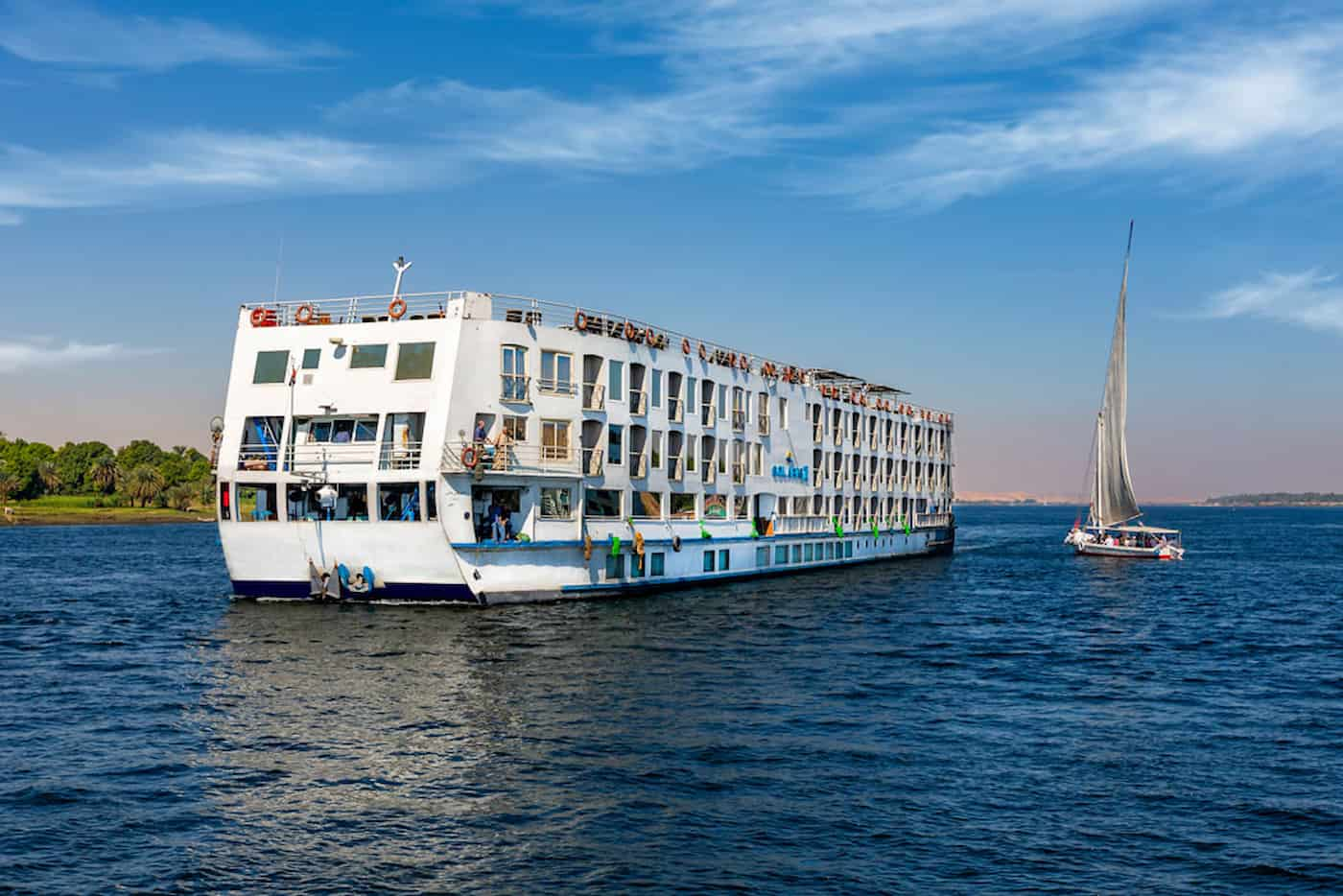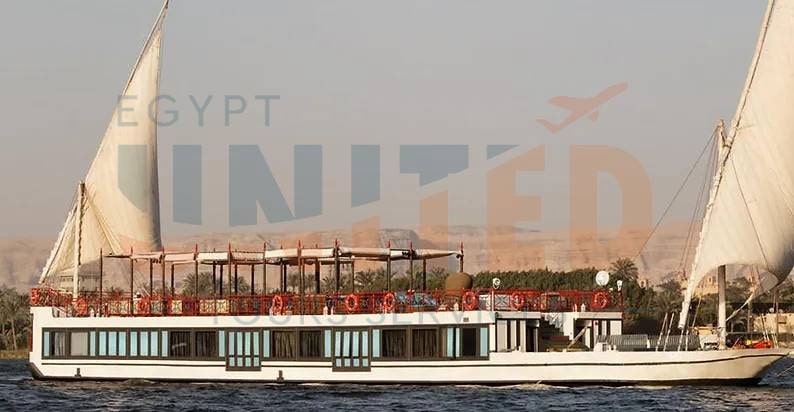Education in Egypt: The Education System in Egypt, Challenges, Obstacles, and Distance Education
Education in Egypt is compulsory for nine academic years for children between the ages of four and 14. Free education is guaranteed under the constitution at all grades and stages in governmental schools and public universities. So there are ultimately no formal admissions requirements for enrollment in elementary schools. While public education at the elementary level is free in theory, in practice, the schools do ask for nominal fees. These fees can range from 210 to 520 Egyptian pounds (approximately US$5–10) per year, though they are waived for some low-income students. The public education system in Egypt is structured into three levels. The basic education stage serves children aged 4 to 14 and includes kindergarten for two years, followed by primary school for six years and preparatory school for three years. Then the secondary education stage lasts three years for students aged 15 to 17 and leads to the tertiary level.
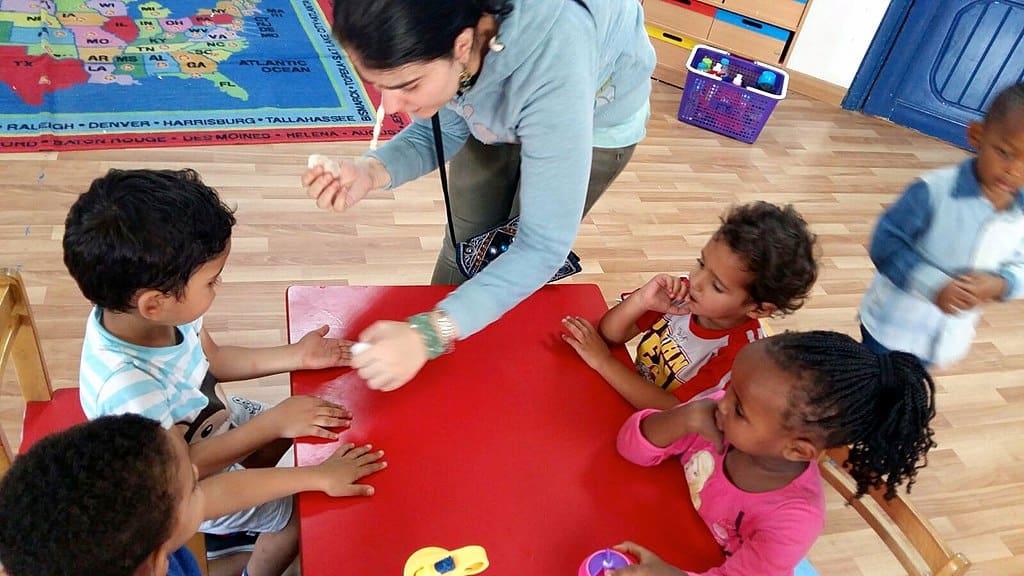
Kindergarten in Egypt
What are the Weekend days in Egypt?
In Egypt, Fridays and Saturdays make up the weekend, with schools having classes on Sundays and Thursdays. This is the general scenario; however, some private schools could follow an entirely different timeslot from Saturday to Wednesday.. In addition, official state holidays for both religious and secular purposes are observed. Vacation periods are divided into two main segments in the phase of the academic calendar. Summer vacation usually falls in early to mid-June and goes on through roughly mid-September, and winter vacation starts from mid-January and lasts until early February.
Plans for Education in Egypt
With support from the World Bank and other multilateral organizations, Egypt is working to expand early childhood education and put ICT into practice at all levels, particularly in higher education. For the fiscal year 2024/2025, public expenditure on education makes up 5.3% of total spending.
The Human Rights Measurement Initiative reports that Egypt achieves 65.5% of what should be possible for the right to education, relative to its income level. The overall literacy rate in Egypt was 72 percent as of 2010, with a gender breakdown of 80.3 percent for males and 63.5 percent for females.
The History of Education in Egypt
1- The Education in Antiquity
Education in Egypt has a long and distinguished history and dates back to ancient times. The ancient Egyptians are credited with the invention of writing and recorded their language using hieroglyphs and established “Bar Ankh” (House of Life). It is the first known school and library in human history. Students from various social backgrounds were enrolled at an early age, typically between five and ten years old. During the Coptic period, educational institutions became associated with churches rather than with temples. Thus came about the establishment of the Theological School in Alexandria. Egypt was an academic and intellectual center attracting out-of-country scholars and making significant contributions in all walks of life, i.e., science, literature, and arts.

Alexandria University
Alexandria had a university dating back to 300 BCE. This university became a hub for notable scholars such as Archimedes and Euclid. Lectures were delivered in a structured manner, like the academic systems of modern universities
2-The Education in Medieval Egypt
During the Fatimid period, two key institutions emerged in Cairo that would shape the intellectual trajectory of Islamic education: al-Azhar and the Dar al-Ilm. Al-Azhar was founded in 970–972 CE under the direction of Jawhar al-Siqilli following the Fatimid conquest of Egypt, initially congregational mosque before developing into a leading center for the study of Shi‘a jurisprudence and theology. While it later became a Sunni institution, al-Azhar’s early educational character was informal, revolving around the presence of scholars who attracted students through their reputation and mastery. In contrast, the Dar al-Ilm (also known as the House of Knowledge), established in 1005 CE by Caliph al-Hakim bi-Amr Allah, was conceived as a state-sponsored center of higher learning and public access.
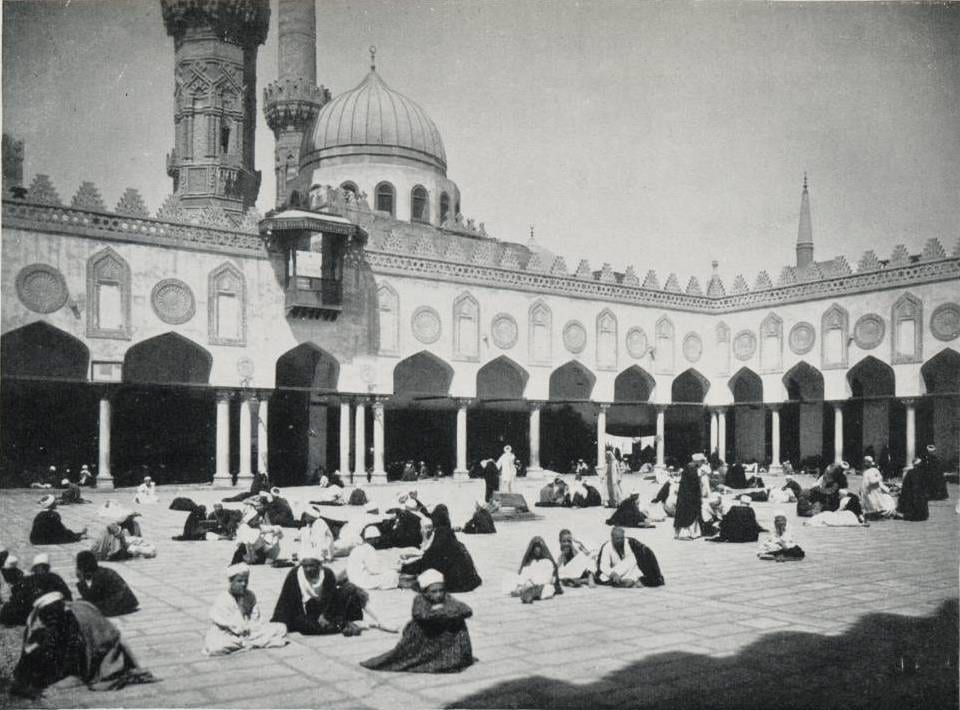
El Azhar University
the Dar al-Ilm
It combined the functions of a library, academy, and scholarly forum to provide instruction in various disciplines, such as astronomy, medicine, grammar, and theology. The institution was notable for its accessibility, salaried teachers, and vast manuscript collection, reportedly exceeding 100,000 volumes, including 18,000 manuscripts on early civilizations.
Although the religious and political priorities of the Fatimid regime shaped both al-Azhar and Dar al-Ilm, al-Azhar endured and evolved, while Dar al-Ilm, despite its early prominence, was eventually dismantled amidst political instability.
Were The Religious Schools the principal mechanism of education?
Education during the Ayyubid and Mamluk periods (c. 12th–16th centuries) remained characterized by a decentralized and socially embedded structure of knowledge transmission. Instruction was primarily informal and rooted in interpersonal relationships between scholars and students. The primary method of accreditation was by way of an ijāza, namely, a license issued by the scholar to authorize a student to teach or transmit specific texts. Pedagogy was disconnected from formal institutional settings and took place at a variety of venues, such as mosques, private homes, and public areas like markets and courtyards. Religious schools did exist and were often endowed by religious foundations, but they were not the main channel through which teaching was imparted. These thus had limited use as teaching institutes since, for the most part, they had become tools for social prestige and political patronage.
Did women have a Role in Education during Medieval Egypt?
Women’s participation in education was not absent, although restricted by prevailing norms. Some women were active in the transmission of hadith and attended scholarly gatherings, while others contributed through the endowment of educational and religious institutions. Documentation also indicates a degree of literacy among elite women. That means their involvement in the intellectual life of the time, albeit in limited and often informal capacities.
Education during the French expedition
The French expedition into Egypt in 1798 thus became a prime historical landmark in the development of modern intellectualism in Egypt. The auspicious setting up of the Institut d’Égypte in Cairo by Napoleon on 22 August 1798 saw it divided into four sections: mathematics, natural sciences, political economy, and literature and arts. The institute hired the crème-de-la-crème of scientists, engineers, and artists in the study of Egypt’s natural resources, antiquities, and society, as well as to fulfill immediate tactical solutions like the production of weapons, purification of water, and public health measures. Research was published in periodicals La Décade Égyptienne and Courrier d’Égypte. Ultimately, all these efforts came together in making the 25-volume Description de l’Égypte, which was compiled and published in France from 1809 to 1828.
Muhammad Ali’s Educational Reforms
- After the French withdrawal, Egypt entered a phase of decline until Muhammad Ali‘s reign (1805–1848). He revived learning through educational reform and cultural investment. The original Institut d’Égypte was reconstituted in 1836 as The Egyptian Society, with a focus on antiquities and book collection. The institute included studies in medicine, agriculture, Egyptology, and the sciences.
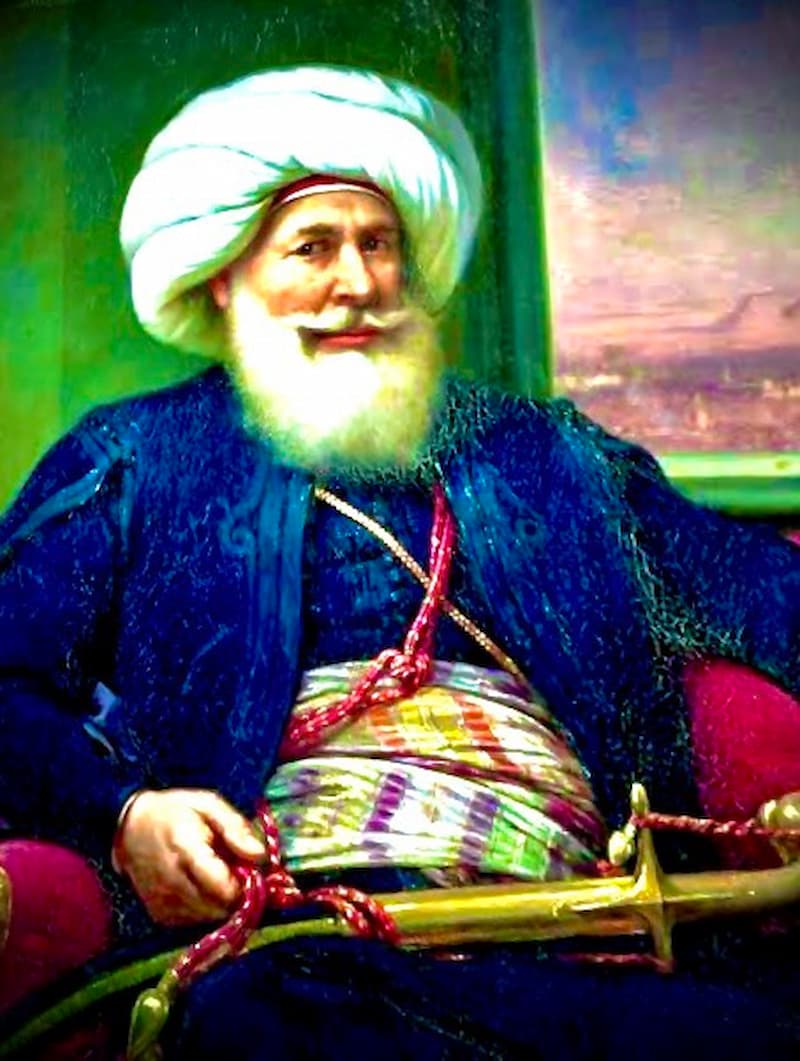
Muhammad Ali King
- Muhammad Ali sent two organized student missions to France to introduce the educational system. His efforts created a dual system: traditional religious schools (mansouri) and modern secular institutions known as schools. The Mansouri system focused on memorization and recitation of the Qur’an.
- Scientific and intellectual life diversified under Khedive Ismail and his successors. The Geographic Society was founded in 1875 to carry out geographic research, especially in Africa. In 1882, the first Arabic Language Institute was established, later reconstituted in 1932 under state patronage to modernize Arabic. The Agricultural Society was founded in 1898 to improve cultivation and combat pests. Other notable bodies include the Egyptian Society for Political Economy, Statistics, and Legislature (1909), the Fine Art Lovers Society (1923), and several scientific and cultural associations in fields such as medicine, entomology, law, archaeology, and the arts.
Education Post-independence
After the Egyptian Revolution of 1952, Gamal Abdel Nasser introduced sweeping reforms, including free public education for all Egyptian children. These instruments assess education quality through a standardized testing procedure such as the Trends in International Mathematics and Science Study (TIMSS). The latest set of results reported states that, in 2015, Egypt was at position 49 in the list of 50 countries concerning reading scores for fourth-grade students, 34th position among 39 countries for mathematics in the eighth grade, and 38th in science at this level among the 39 ranked nations. However, reform efforts aimed at active-learning methodologies and decentralizing school administration, combined with computer technology use, have registered limited success owing mainly to structural difficulties in the education system.
Obstacles to Education
The lack of progress has been due to traditional methods of teaching, high student-to-teacher ratios, lack of infrastructure, low level of teacher status, and the use of rote memorization in examinations.
Distance Education
The COVID-19 Pandemic has had a strong influence on the Egyptian educational system and the rise of distance education. The results of a study on a sample of 147 students showed that students appreciated comfort in the home environment, saving time and effort, and having better access to learning resources.
The education system in Egypt
The Egyptian educational system is highly centralized. It is divided into three main levels, with the first one being compulsory for all children. The primary and preparatory phases from ages 6 to 14 have been collectively categorized under the term basic education. Advancement after this stage depends on individual student performance. In addition, many private schools offer alternative educational programs that complement the national curriculum, like the American High School Diploma, the British IGCSE system, the French baccalauréat, the German Abitur, and the International Baccalaureate.

Cairo High School
1- Basic education
At the basic level, children aged 4 to 14 receive education beginning with two years of kindergarten, then six years of primary school, and three years in preparatory school. This phase is succeeded by a three-year secondary school stage for students aged 15 to 17, after which tertiary education starts.
Compulsory education covers nine academic years between the ages of 4 and 14, and all levels are provided free of charge in government-run institutions. According to the World Bank, disparities exist in the educational attainment of rich and poor students. This is a phenomenon called the “wealth gap”.
2- Secondary education
After the successful completion of basic education and its corresponding national examination, students progress to secondary education, which is divided into two distinct tracks, general and technical. The general track lasts three years, while technical programs extend between three and five years and cover disciplines such as industrial, agricultural, and commercial studies. Some technical institutions also operate a dual education system. More recently, the government has introduced Applied Technology Schools to further enhance technical and vocational education and training (TVET). In 2006, the Industrial Training Council (ITC) was established by ministerial decree to coordinate all TVET-related initiatives, projects, and policies.
3- Higher education in Egypt
Egypt’s vast educational system encompasses the gamut from public to private institutions. Public higher education institutions charge fees as minimal as 400,500 to 5000 EGP Personal Mention (about US$10-100) per annum, private institutions, however, charge considerably higher tuition fees. Approximately 30% of Egyptians in the age group relevant to higher education attend university; however, less than half manage their graduate.
The Ministry of Higher Education supervises the tertiary level of education. The current system comprises a diverse range of institutions, including 27 public universities, 51 public non-university institutions, 27 private universities, and 89 private higher institutions. Among the 51 public non-university institutions, 47 are two-year middle technical institutes (MTIs) and four are four- to five-year higher technical institutes. The higher education students may increase by nearly 6 percent (approximately 60,000 students) per annum through 2009.
The development of Higher Education
Because of the increase in students, significant efficiency improvements will be required merely to sustain current quality levels. The Egyptian government acknowledges the challenges confronting the higher education sector. In response, the Ministry of Higher Education has taken a leading role in reform initiatives. In 1997, the minister established the Higher Education Enhancement Project (HEEP) Committee, which convened a wide range of stakeholders, including industrialists and parliamentarians. A National Conference on Higher Education Reform was convened in February 2000. This declaration, which identified 25 specific reform initiatives, has garnered support from multilateral and bilateral agencies, including the World Bank.
In August 2004, HEEP’s strategic priorities were adjusted to address quality and accreditation concerns and to align with the government’s emphasis on scientific research. This adjustment included two additional dimensions: the development of postgraduate studies and scientific research, and the enhancement of students’ extracurricular activities alongside the continued implementation of the six originally prioritized programs. In July 2025, Egypt announced a Japan-inspired engineering diploma. The diploma will begin teaching in September 2025.

Cairo University
The QS World University Rankings 2025 includes 15 Egyptian universities, with Cairo University ranked 350th among them. The American University in Cairo follows, improving its position to 410th place. Several Egyptian universities have advanced in rankings compared to the previous year. This reflects ongoing improvements in higher education.
4- International education in Egypt
As of January 2015, the International Schools Consultancy (ISC) reported that Egypt had 184 international schools. International schools in Egypt are privately operated institutions that deliver curricula from foreign countries. Instruction is primarily conducted in English or in the language of the school’s country of origin. Some schools offer bilingual programs.
A majority of these schools follow either the British curriculum, the American system, or the International Baccalaureate (IB) framework, although several institutions also follow French or German educational models. Despite their relatively high tuition fees, international schools provide students with the opportunity to receive a Western-style education that emphasizes critical thinking, global awareness, and robust preparation for higher education both within Egypt and abroad.
5- Al-Azhar system
Another system that operates concurrently with the public educational system is the Al-Azhar system. This system consists of a six-year primary stage, a three-year preparatory stage, and a three-year secondary stage. In 1998, the Ministry of Education reduced the number of secondary school years from four to three to align the Al-Azhar system with the general secondary education system. In this framework, separate schools are maintained for girls and boys.
The Supreme Council of the Al-Azhar Institution supervised the Al-Azhar educational system. Although the Azhar Institution is nominally independent of the Ministry of Education, it ultimately is under the supervision of the Egyptian Prime Minister. Al-Azhar schools, designated as “Institutes,” encompass primary, preparatory, and secondary phases. All stages include instruction in both religious and non-religious subjects; however, the curriculum emphasizes religious studies, and enrollment is limited to Muslim students.

Smouha_Al-Azhar_Institute, Education in Egypt
As of 2007 and 2008, there were 8,272 Al-Azhar schools in Egypt. In the early 2000s, these schools accounted for less than 4% of total enrollment. Furthermore, graduates from the Al-Azhar system are automatically admitted to Al-Azhar University, and in 2007, pre-university enrollment in Al-Azhar institutes was approximately 1,906,290 students.
6- Agricultural education in Egypt
The Egyptian Ministry of Education, to enhance agricultural knowledge and skills among young people, established 133 secondary agricultural schools across various cities and districts by the 2010/2011 academic year. These institutions offer two distinct pathways in agricultural education, comprising a three-year system and a five-year system. Both pathways deliver a combination of theoretical instruction in classroom settings and practical training through laboratories, workshops, and on-site farm experiences.
Furthermore, these schools collaborate closely with the Ministry of Agriculture to facilitate training opportunities for their teaching staff at agricultural research centres and focus on technical farming issues. Additionally, farming plots are allocated to the schools, thereby providing practical training environments and creating job opportunities for graduates at institutions affiliated with the Ministry of Agriculture.
Internet and Social Media Usage in Education in Egypt
The internet has revolutionized several businesses in the digital age, including education, and has impacted every facet of our lives. The accessibility and scope of online resources have fundamentally changed how students study and how teachers disseminate information. The internet has significantly changed how people learn, opening up new possibilities for independent study, teamwork, and research.
Conclusion
Egypt has the most extensive education system in the Middle East. It has more than 60,000 schools, of which only 7,000 are private schools. Public primary schools accommodate about 20 million students, and private primary schools accommodate around 2 million students. The total number of students in the primary stage is expected to reach 30 million by 2030. According to UNESCO’s Student Mobility Data, Egypt has 43,718 students pursuing higher-level education abroad.




